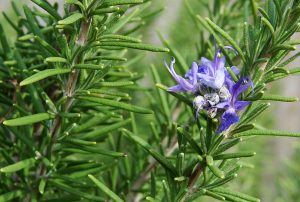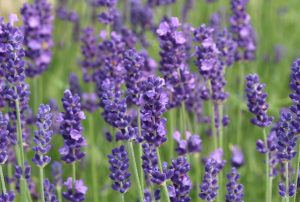Oregano (US /ɔːˈrɛɡənoʊ/ or /əˈrɛɡənoʊ/; UK /ˌɒrɪˈɡɑːnoʊ/;scientific name Origanum vulgare) is a common species of Origanum, a genus of the mint family (Lamiaceae). It is native to warm-temperate western and southwestern Eurasia and the Mediterranean region.
Oregano is a perennial herb, growing from 20–80 cm tall, with opposite leaves 1–4 cm long. Oregano will grow in a pH range between 6.0 (mildly acidic) and 9.0 (strongly alkaline) with a preferred range between 6.0 and 8.0. The flowers are purple, 3–4 mm long, produced in erect spikes. It is sometimes called wild marjoram, and its close relative O. majorana is known as sweet marjoram.
Description and biology
Oregano is related to the herb marjoram, sometimes being referred to as wild marjoram. Oregano has purple flowers and spade-shaped, olive-green leaves. It is a perennial, although it is grown as an annual in colder climates, as it often does not survive the winter months. Oregano is planted in early spring, the plants being spaced 30 cm (12 in) apart in fairly dry soil, with full sun. It prefers a hot, relatively dry climate, but will do well in other environments
Taxonomy
Many subspecies and strains of oregano have been developed by humans over centuries for their unique flavors or other characteristics. Tastes range from spicy or astringent to more complicated and sweet. Simple oregano sold in garden stores as Origanum vulgare may have a bland taste and larger, less dense leaves, and is not considered the best for culinary uses, with a taste less remarkable and pungent. It can pollinate other more sophisticated strains, but the offspring are rarely better in quality.
The related species, Origanum onites (Greece, Turkey) and O. syriacum (West Asia), have similar flavors. A closely related plant is marjoram from Turkey, which, however, differs significantly in taste, because phenolic compounds are missing from its essential oil. Some varieties show a flavor intermediate between oregano and marjoram.
Subspecies
Accepted subspecies:
Origanum vulgare subsp. glandulosum (Desf.) Ietsw. – Tunisia, Algeria
Origanum vulgare subsp. gracile (K.Koch) Ietsw. (= O. tyttanthum) has glossy green leaves and pink flowers. It grows well in pots or containers, and is more often grown for added ornamental value than other oregano. The flavor is pungent and spicy. – Central Asia, Iran, India, Turkey, Afghanistan, Pakistan.
Origanum vulgare subsp. hirtum (Link) Ietsw. – (Italian oregano, Greek oregano) is a common source of cultivars with a different aroma[8] from those of O. v. gracile. Growth is vigorous and very hardy, with darker green, slightly hairy foliage. Generally, it is considered the best all-purpose culinary subspecies. – Greece, Balkans, Turkey, Cyprus
Origanum vulgare subsp. virens (Hoffmanns. & Link) Ietsw. – Morocco, Spain, Portugal, Balearic Islands, Canary Islands, Azores, Madeira
Origanum vulgare subsp. viridulum (Martrin-Donos) Nyman – widespread from Corsica to Nepal
Origanum vulgare subsp. vulgare – widespread across Europe + Asia from Germany to China; naturalized in North America + Venezuela
Cultivars
Example cultivars are:
‘Aureum’ – Golden foliage (greener if grown in shade), mild taste. It has gained the Royal Horticultural Society’s Award of Garden Merit.
‘Greek Kaliteri’ – O. v. hirtum strains/landraces, small, hardy, dark, compact, thick, silvery-haired leaves, usually with purple undersides, excellent reputation for flavor and pungency, as well as medicinal uses, strong, archetypal oregano flavor (Greek kaliteri: the best).
‘Hot & Spicy’ – O. v. hirtum strain
‘Nana’ – dwarf cultivar
Cultivars traded as Italian, Sicilian, etc. are usually hardy sweet marjoram (O. ×majoricum), a hybrid between the southern Adriatic O. v. hirtum and sweet marjoram (O. majorana). They have a reputation for sweet and spicy tones, with little bitterness, and are prized for their flavor and compatibility with various recipes and sauces.
Culinary
Oregano is an important culinary herb, used for the flavour of its leaves, which can be more flavourful when dried than fresh. It has an aromatic, warm and slightly bitter taste, which can vary in intensity. Good quality oregano may be strong enough almost to numb the tongue, but the cultivars adapted to colder climates often have a lesser flavor. Factors such as climate, seasons and soil composition may affect the aromatic oils present, and this effect may be greater than the differences between the various species of plants. Among the chemical compounds contributing to the flavour are carvacrol, thymol, limonene, pinene, ocimene, and caryophyllene.
Oregano’s most prominent modern use is as the staple herb of Italian-American cuisine. Its popularity in the US began when soldiers returning from World War II brought back with them a taste for the “pizza herb”, which had probably been eaten in southern Italy for centuries. There, it is most frequently used with roasted, fried or grilled vegetables, meat and fish. Unlike most Italian herbs,[citation needed] oregano combines well with spicy foods, which are popular in southern Italy. It is less commonly used in the north of the country, as marjoram generally is preferred.
The herb is also widely used in Turkish, Palestinian, Lebanese, Egyptian, Syrian, Greek, Portuguese, Italian, Spanish, Philippine and Latin American cuisines.
In Turkish cuisine, oregano is mostly used for flavoring meat, especially for mutton and lamb. In barbecue and kebab restaurants, it can be usually found on table, together with paprika, salt and pepper.
The dried and ground leaves are most often used in Greece to add flavor to Greek salad, and is usually added to the lemon-olive oil sauce that accompanies many fish or meat barbecues and some casseroles.
Oregano is also used by chefs in the southern Philippines to eliminate the odor of carabao or water buffalo when boiling it, while simultaneously imparting flavor.
Phytochemicals and folk medicineIn the myths of folk medicine, Hippocrates used oregano as an antiseptic, as well as a cure for stomach and respiratory ailments. A Cretan oregano (O. dictamnus) is still used today in Greece as a palliative for sore throat.
Oregano contains polyphenols, including numerous flavones.
In Austrian folk medicine, oregano was used internally (as tea) or externally (as ointment) for treatment of disorders of the gastrointestinal tract, respiratory tract, and nervous system.
In 2005, the US Federal Trade Commission brought legal action against a firm that had claimed oil of oregano treated colds and flu, and that oil of oregano taken orally treated and relieved bacterial and viral infections and their symptoms,[16] saying the representations were false or were not substantiated at the time the representations were made, and that they were therefore a deceptive practice and false advertisements.The final stipulation on the matter said no representation as to any health benefit could be made without “…competent and reliable scientific evidence…”.
Chemical components
The essential oil of oregano is composed primarily of monoterpenoids and monoterpenes, however the concentrations of the specific compounds vary widely depending on geographic location and other varying factors. Over 60 different compounds have been identified with the primarily ones being carvacrol and thymol ranging from 0 over 80% while lesser abundant compounds include p-cymene, γ-terpinene, caryophyllene, spathulenol, germacrene-D, β-fenchyl alcohol and δ-terpineol.
Drying of the plant material affects both quantity and distribution of volatile compounds, with methods using higher heat and longer drying times having greater negative impact. A sample of fresh whole plant material found to contain 33g/kg dry weight (3.1g/kg wet) decreased to below a third after warm air convection drying. Much higher concentrations of volatile compounds are found to be towards the end of the growing season.
Other plants called “oregano”
Cuban oregano or oregano poleo (Plectranthus amboinicus, formerly Coleus aromaticus), also of the mint family (Lamiaceae). Sometimes also called “Mexican mint or Mexican thyme”, it has large and somewhat succulent leaves. Not just a Latin American plant, it’s also grown and used throughout the tropics, including Africa and Southeast Asia.
Mexican oregano (Lippia graveolens) is not of the mint, but of the closely related vervain family (Verbenaceae), including, e.g. the lemon verbena (Aloysia citrodora). It is a highly studied herb that is said to be of some medical use and is common in curandera (female shamanic practices) in Mexico and the Southwestern United States. The flavor of Mexican oregano has a stronger savory component instead of the piney hint of rosemary flavor in oregano, and its citrus accent might be more aromatic than in oregano. It is becoming more commonly sold outside of Mexico, especially in the United States, where it is an important source of dried oregano. It is sometimes used as a substitute for epazote leaves; this substitution would not work the other way round. Epazote has a lighter, and even more savory flavor and citrus accent than Mexican oregano, and of course, a very strong sweet tarragon-like flavor which might be its strongest component. When Mexican oregano is substituted for epazote, the base flavor less the tarragon-like sweetness is provided, and other corrections to the recipe may cover for the missing tarragon component of epazote, or the dish may be served without that flavor component. If epazote were substituted for Mexican oregano, many dishes would be overpowered by the tarragon accent.
Poliomintha longiflora is also occasionally called orégano in America.
Etymology
Oregano is the anglicised form of the Italian word origano, or possibly of the medieval Latin organum; this latter is used in at least one Old English work. Both were drawn from the Classical Latin term origanum, which probably referred specifically to sweet marjoram, and was itself a derivation from the Greek ὀρίγανον (origanon), which simply referred to “an acrid herb”. The etymology of the Greek term is often given as oros ὄρος “mountain” + the verb ganousthai γανοῦσθαι “delight in”, but the Oxford English Dictionary notes it is quite likely a loanword from an unknown North African language.








